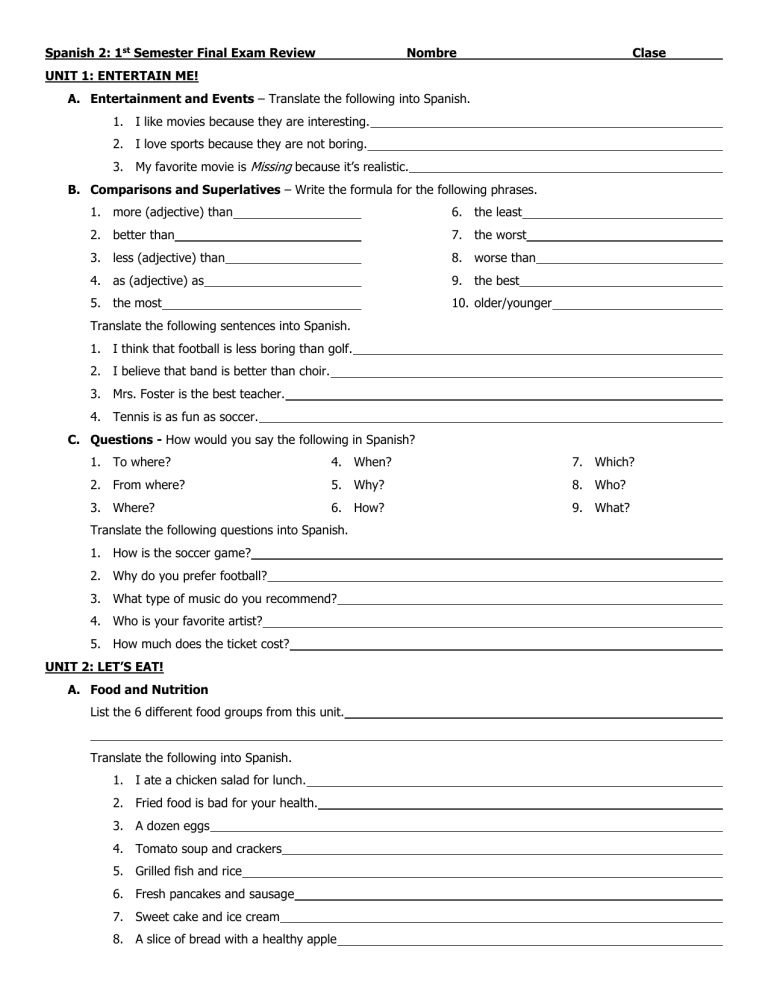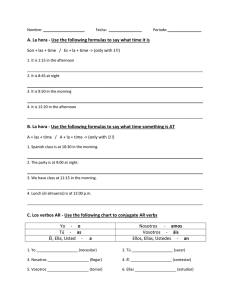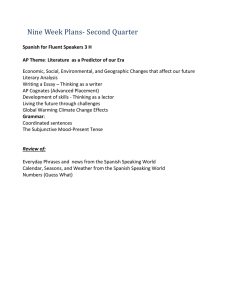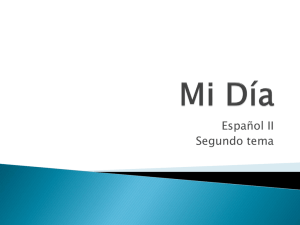
Spanish 2: 1st Semester Final Exam Review Nombre Clase UNIT 1: ENTERTAIN ME! A. Entertainment and Events – Translate the following into Spanish. 1. I like movies because they are interesting. 2. I love sports because they are not boring. 3. My favorite movie is Missing because it’s realistic. B. Comparisons and Superlatives – Write the formula for the following phrases. 1. more (adjective) than 6. the least 2. better than 7. the worst 3. less (adjective) than 8. worse than 4. as (adjective) as 9. the best 5. the most 10. older/younger Translate the following sentences into Spanish. 1. I think that football is less boring than golf. 2. I believe that band is better than choir. 3. Mrs. Foster is the best teacher. 4. Tennis is as fun as soccer. C. Questions - How would you say the following in Spanish? 1. To where? 4. When? 7. Which? 2. From where? 5. Why? 8. Who? 3. Where? 6. How? 9. What? Translate the following questions into Spanish. 1. How is the soccer game? 2. Why do you prefer football? 3. What type of music do you recommend? 4. Who is your favorite artist? 5. How much does the ticket cost? UNIT 2: LET’S EAT! A. Food and Nutrition List the 6 different food groups from this unit. Translate the following into Spanish. 1. I ate a chicken salad for lunch. 2. Fried food is bad for your health. 3. A dozen eggs 4. Tomato soup and crackers 5. Grilled fish and rice 6. Fresh pancakes and sausage 7. Sweet cake and ice cream 8. A slice of bread with a healthy apple B. Affirmative Tú Commands In order to change a verb into the affirmative tú command form, you use the _______________________ form of the present tense form of the verb. Change the verbs below into the affirmative tú command forms. (some are irregular!) 1. Put 4. Leave 7. Say/tell 2. Read 5. Have 8. Come 3. Make/do 6. Talk 9. Swim UNIT 3: MY DAILY LIFE A. Daily Activities and Routines – Translate the following into Spanish. 1. I cut the grass in the afternoon. 2. They do their homework after school. 3. I shower before I go to bed. 4. You clean the bathroom and kitchen. 5. She vacuums the living room. B. Reflexive Verbs are verbs in which the is reflected back on the action. In the infinitive form of a reflexive verb, the reflexive verbs end in pronouns are: , , , conjugated verbs, or they are attached when an performing the . The reflexive verb , . Pronouns go form of the verb is required. Conjugate the following reflexive verbs in the present tense. (Don’t forget to use the reflexive pronouns!) Yo Tú Él, Ella, Nosotros/as Usted Ellos, Ellas, Ustedes Secarse Acostars e Vestirse Lavarse Translate the following sentences into Spanish. 1. I put on perfume. 2. We brush our teeth. 3. You get ready in the morning. 4. He showers in the bathroom. MISCELLANEOUS GRAMMAR REVIEW A. Subject Pronouns: Give the corresponding Spanish subject pronouns for the following subjects. 1. I 4. She 2. You (informal) 5. You (formal) 3. He 6. We (masculine) 7. We (feminine) 12. Pedro y Maria 8. They (masculine) 13. Anita y Ana 9. They (feminine) 14. Fernando y yo 10. You (plural) 15. Pepe y Luis 11. Juan 16. Silvia B. Ser and Estar Ser means . It is used to describe someone’s physical . It can also identify nouns. Conjugate the verb “ser” below. Yo traits and Nosotros/Nosotras Tú Él/Ella/Usted Ellos/Ellas/Ustedes Translate the following sentences into Spanish. 1. I am short and pretty. 2. They (m.) are organized and smart. Estar – means . Conjugate “estar” below. Yo Nosotros/Nosotras Tú Él/Ella/Usted Ellos/Ellas/Ustedes Ser & Estar – both verbs mean . Ser is used when referring to . Estar is used when referring to . C. Tener means . It is used to discuss someone’s and characteristics. Conjugate the verb “tener” below. Yo Nosotros/Nosotras Tú Él/Ella/Usted Ellos/Ellas/Ustedes D. Adjectives and Gender/Number Agreement a. Most masculine/singular nouns and adjectives end in . b. Most feminine/singular nouns and adjectives end in . c. Most masculine/plural nouns and adjectives end in . d. Most feminine/plural nouns and adjectives end in . e. Adjectives and nouns that end in are gender neutral. f. Adjectives that end in –dor usually have a feminine form that ends in . g. In Spanish, adjectives usually go the noun. h. If a noun ends in a vowel (a,e,i,o,u), we make it plural by adding _____________ to the end of the word. i. If a noun ends in a consonant, we make it plural by added __________________ to the end of the word. j. If a noun is masculine, the adjective that describes it must be __________________________________. k. If a noun is feminine, the adjective that describes it must be ___________________________________. l. If a noun is plural, the adjective that describes it must also be __________________________________. Translate the following phrases into Spanish. 1. The smart girls 2. The disorganized boy 3. The short girl 4. The lazy students (m) 5. The hard-working teachers (f) E. How do you say “There is/There are” in Spanish? F. Possession There is no apostrophe in Spanish. What word takes the place of the apostrophe in Spanish? Translate the following into Spanish. 1. Juan’s book 2. My notebook 3. His pens 4. Their dictionaries 5. Our classes G. Present Progressive Tense is similar to the English . You form the present progressive tense by combining the present tense forms of the verb the with . The ing ending for ar verbs is The ing ending for er/ir verbs is . Translate the following sentences into Spanish. 1. I am writing. 2. You are working. 3. He is eating. H. Prepositions – Translate the following prepositions into English. I. 1. A 8. Para 2. Antes de 9. Sobre 3. Después de 10. Bajo 4. Con 11. Sin 5. De 12. Entre 6. En 13. Detrás de 7. Por 14. Contra Contractions 1. a + el = 2. de + el = . J. Tener + que + Infinitive This formula is used in order to tell what someone _________________________________________________. Translate the following sentences into Spanish. 1. I have to study. 2. He has to practice soccer. K. Ir + a + Infinitive This formula is used in order to tell what someone _________________________________________________. The word “a” in Spanish means . Translate the following sentences into Spanish. 1. I’m going to go to school. 2. We are going to do homework. L. Define the following grammar terms. Give examples in English/Spanish. a. Verb: b. Noun: c. Adjective: d. Cognate: e. Infinitive: M. Definite and Indefinite Articles _______ and _____________ mean the and are called definite articles. Use __________ for masculine nouns and ______________ for feminine nouns. _________________ and _________________ mean a or an and are called indefinite articles. Use _________________ for masculine nouns and ____________________ for feminine nouns. Fill in the chart below with the correct definite articles in Spanish and write the English translations. Masculine/singular Masculine/plural Feminine/singular Feminine/plural Fill in the chart below with the correct indefinite articles in Spanish and write the English translations. Masculine/singular Masculine/plural Feminine/singular Feminine/plural N. Irregular Verb: Ir – The verb “ir” means Yo . Conjugate the verb “ir” below. Nosotros/Nosotras Tú Él/Ella/Usted Ellos/Ellas/Ustedes O. Present Tense Conjugation What is the stem of a verb? _______________________________________________________________________ What are the endings for ar, er, and ir verbs when conjugating in the present tense? AR ER IR Yo Tú Él, Ella, Usted Nosotros/Nosotras Ellos, Ellas, Ustedes Conjugate the following verbs in the present tense. Yo Tú (* means they are irregular) Él, Ella, Usted Hablar Vivir Comer Leer *Dormir *Pedir *Ver *Hacer *Poner *Salir *Venir *Empeza r *Poder *Querer Nosotros/as Ellos, Ellas, Ustedes *Pensar *Jugar *Preferir P. Gustar is not conjugated like regular verbs in Spanish. First, you need to use pronouns. These pronouns are ______ , ______ , ______ , ______ , ______ . Then, you use the two forms of gustar. They are: _________________,__________________ . To say you like one thing, use _________________ (I like) or _________________ (I love). To say you like/love more than one thing, use _________________ or _________________ . Put ____________ in front of me gusta or me gustan to say you don’t like one or more things. Translate the following into Spanish. 1. I like to play golf. 2. You like to swim. 3. He likes to play the guitar. 4. We like to sing. 5. They like to practice sports. Q. Saber and Conocer – both mean . Saber is used to discuss . Conocer is used to discuss . Both are irregular in the yo form. Yo (saber) . is Yo (conocer) is . R. Direct Object Pronouns What is a direct object? What are the direct object pronouns? PRETERITE AND IMPERFECT P. Preterite Tense Conjugation – Write the endings below for conjugating verbs in the preterite tense. AR ER IR Yo Tú Él, Ella, Usted Nosotros/Nosotras Ellos, Ellas, Ustedes Conjugate the following verbs in the preterite tense. Yo Tú Él, Ella, Usted Nosotros/as Ellos, Ellas, Ustedes Ser/Ir Hacer Tener Estar Poder Empezar Tocar Jugar Leer Saber Dormir Sentir Querer Decir Venir Q. Imperfect Tense Conjugation – Write the endings below for conjugating verbs in the imperfect tense. AR Yo Tú Él, Ella, Usted Nosotros/Nosotras Ellos, Ellas, Ustedes Conjugate the following verbs in the imperfect tense. ER IR Yo Él, Ella, Tú Nosotros/as Usted Ellos, Ellas, Ustedes Ir Ser Ver Jugar Tener Vivir Saltar Corer R. Preterite and Imperfect Tense You use the _______________________ to tell what was happening and the ____________________ to tell what happened. You use the _______________________ to discuss time and repeated actions in the past. You use the __________________ to discuss specific moments of action in the past that have a specific beginning/end. Translate the following sentences into Spanish. 1. I went to the mall yesterday. 2. You went to Cabell Midland High School. 3. She used to play the clarinet. 4. We jumped at the sound. 5. I lived in Ona. 6. The concert started at 10p.m. 7. He spoke for 2 hours. 8. They played soccer. **REMINDERS** Make sure that you have a hard copy of all vocabulary! Check your vocabulary on Quizlet! TAPAS are on http://senorafoster.weebly.com Click on the “Fall Review” section under “Spanish 2”


